IDEX Online Research: Jewelers’ Average Ticket about Flat in 2008; Down in 2009
October 21, 09
The average ticket for most U.S. jewelers in 2008 was nearly flat when compared to their average ticket for 2007, according to a survey recently completed by IDEX Online Research. In 2009, it appears that the average ticket for diamond jewelry in the U.S. market has declined by about 10 percent on average. Here are the highlights of this survey:
- Mass market chain jewelers posted an average ticket of about $350 in 2008, just about the same as the previous year.
- Guild jewelers’ average ticket held fairly steady around $1,200 in 2008, though guild jewelers who generate higher average tickets – $3,000 and above – experienced some modest erosion in their average ticket.
- The average ticket for a diamond engagement ring fell slightly to near $3,250 in 2008, down from $3,450 in 2007. This includes the average of all diamond engagement rings sold by specialty jewelers, discounters (such as Wal-Mart), and others.
- The average ticket for most diamond jewelry has slipped by an average of about 10 percent in 2009, based on early indications from merchants who sell jewelry.
Jewelers noted that while the recessionary environment did not seem to have much of an impact on the number of weddings, there has been a reduction in total amount spent on bridal jewelry, including the key piece: the diamond engagement ring. We are currently estimating that the average ticket for a diamond engagement ring in 2009 will be in the range of $3,200, down from the previous year’s $3,450.
IDEX Online Research is forecasting that the average ticket will continue to decline modestly in 2009. However, since late summer, there appears to have been a gradual increase in the number of transactions that jewelers are posting. Clearly, there has been some modest improvement in mall traffic. This has boosted traffic into jewelers’ stores. And, apparently, jewelers’ conversion rate – browsers to buyers – has risen. However, because the average ticket is down, same-store sales have not yet shown a recovery.
Guild Jewelers Suffering
In the current recession, high-end “guild” jewelers have taken a greater hit in sales than mass market jewelers. There appear to be two reasons for this: 1) some shoppers are “shopping down” – that is, they may have shopped at a higher-end guild jeweler, but now they are shopping at a mass market jeweler such as Zale’s; and, 2) some big-ticket shoppers have dropped out of the market – they simply are not spending on jewelry, especially if they previously accumulated their wealth from sources such as the stock market or real estate.
The following table summarizes the average ticket for several guild jewelers. As it shows, the average ticket declined modestly in 2008 versus 2007 for four of the five publicly held jewelers listed.
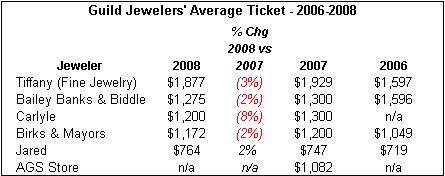 Source: Public documents |
Clearly, the average ticket for a typical guild jewelry store is about $1,200, as the table above illustrates, though Tiffany has a moderately higher average ticket and Jared has a lower average ticket, as we would expect.
Tiffany & Co. – A Special Situation
When most consumers hear the magic words, “Tiffany and company,” it sets off images of sparkling diamonds and shiny precious metals. Several movies have added to the perception that Tiffany & Company is a very high-end jeweler. Clearly, it is a guild level jeweler, but its average ticket dispels the notion that it is an uber-luxury jeweler. IDEX Online Research would classify Tiffany as an accessible luxury jeweler. It has cache for the kings and queens of the world, and it has accessibility for the masses with its sterling silver jewelry.
The table below summarizes its average ticket by four key merchandise categories. It is particularly noteworthy that the average ticket for “bridal jewelry” is only $3,000. While this category includes diamond engagement rings as well as wedding bands and other bridal items, it illustrates that Tiffany has jewelry available at affordable prices. Further, Tiffany’s average ticket for a diamond engagement ring is between $10,000 and $11,000, a very reasonable price for a diamond solitaire in a platinum mount packaged in a blue Tiffany presentation box.
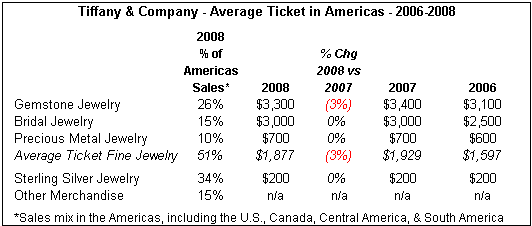
Source: Tiffany & Company & IDEX Online estimates
As the table illustrates, Tiffany’s average ticket was under pressure in 2008, after moving solidly upward in 2007. However, what is important to note is that Tiffany’s average ticket is not at stratospheric levels for any of its product categories. The calculation of Tiffany’s “Average Ticket Fine Jewelry” for 2006, 2007, and 2008 was made by IDEX Online Research based on weighted average sales and pieces sold for each of the three categories; we believe those numbers are within 5 percent of the correct number.
Mass Market Jewelers Report Mixed Trends
The average ticket for mass market jewelers such as Gordon’s and Kay Jewelers show mixed results: some are slightly up, while others have gone down.
In this category, the typical average ticket for a mass market jeweler is around $350, based on data for 2008, as the table below illustrates.
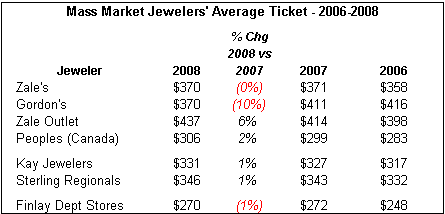
Source: Public documents
Average Ticket Affected Most by Sales Mix
Why do some jewelers report higher or lower average tickets than other jewelers? Some of the difference can be affected by the ability of a jeweler’s salespeople, but a large portion of the difference is affected by a jeweler’s sales mix. Typically, a jeweler with a higher sales mix of diamond jewelry will report a higher average ticket.
IDEX Online Research is preparing a report on the sales mix of each of the publicly held jewelers and others who report their sales mix.
Average Ticket – Diamond Jewelry
Diamond and diamond jewelry sales are the largest merchandise category for most jewelers. According to the most recent Jewelers of America Cost of Doing Business Survey, specialty jewelers generate 49 percent of their annual revenues from diamond jewelry or loose diamond sales.
In the past, De Beers, through its various marketing affiliates in the United States, provided extensive research about diamond jewelry sales. For example, their 1998 “Red Book” contains more than 75 pages of detailed information about the diamond jewelry market in the U.S. Those “good old days” of highly detailed research are gone. Budgets have been reduced, and De Beers’ market share has declined. It now produces only a modest level of research, and since the landscape has gotten much more competitive, it does not share this research broadly.
However, there are other sources for some of the key data which is important for U.S. jewelers. IDEX Online Research uses publicly available data from The Knot, National Jeweler, and other credible sources as well as data from some private sources to confirm the publicly available numbers.
Recently, we have seen some wild guesses in the trade media about the average ticket for a diamond engagement ring. Thus, we spent significant efforts to support our figures and refute or explain any other figures that may exist.
The data we developed regarding the average ticket for selected diamond jewelry items is summarized on the table below. It is important to note that “all merchants” includes sales of specialty jewelers, discounters, mass merchants, and any merchant who sells diamond jewelry. The average diamond carat size for a diamond engagement ring is about three-fourths of a carat for “all merchants.” Our estimates for 2009 are based on year-to-date data from a universe of jewelers and other merchants.
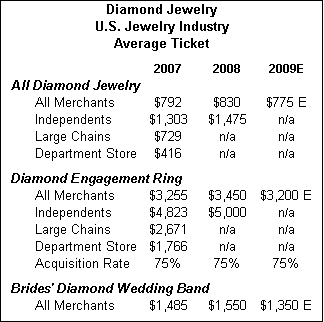 Source: Various credible sources |
The “acquisition rate” shown on the table above indicates the percentage of brides (first-time and subsequent) that receive a diamond engagement ring. Historically, about 79 percent of first-time brides receive a diamond engagement ring while about 70 percent of brides who marry for the second and subsequent times receive a diamond engagement ring.
Average Ticket – Other Views
In addition to total jewelry industry data shown above, there are other sources for specific average diamond jewelry tickets based on specific market segments. The table below summarizes some of the alternative average ticket data from credible sources for certain market segments that we encountered in our search for the jewelry industry average ticket for diamond jewelry.
The specific universes of consumers and jewelers include the following:
- The Knot – Data from The Knot comes from a universe of consumers with above-average income levels who tend to shop at specialty jewelers rather than multi-line merchants such as discounters. Hence, the average ticket for this universe is somewhat higher than the industry average. (Information courtesy of The Knot.)
- National Jeweler – This sample group includes specialty jewelers and other merchants who tend to specialize in jewelry, but it omits some of the very low-end retailers who sell jewelry. Thus, its average ticket data tends to be slightly above average. (Information courtesy of National Jeweler.)
- Blue Nile – Blue Nile appeals to affluent young couples with two incomes. It is no surprise that the average ticket for a diamond engagement ring at Blue Nile is nearly double the industry average. However, Blue Nile’s average ticket for a diamond engagement ring in 2008 was $6,000, down slightly from $6,200 in 2007. (Information courtesy of Blue Nile and its legal filings.)
- Tiffany & Co. – The surprise here is that this guild jeweler’s average ticket for a diamond engagement ring is a very reasonable $10,000 to $11,000. Most people would guess even higher. We have always argued that while Tiffany shows some spectacular jewelry (with a price tag to match), most of its product line is highly affordable, especially given the value of the Tiffany brand. (Information courtesy of Tiffany & Company and its legal filings.)
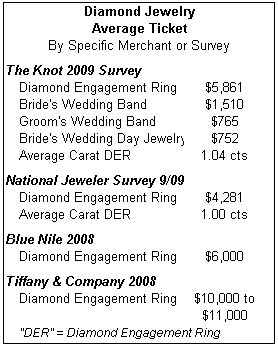
Source: As Noted Above